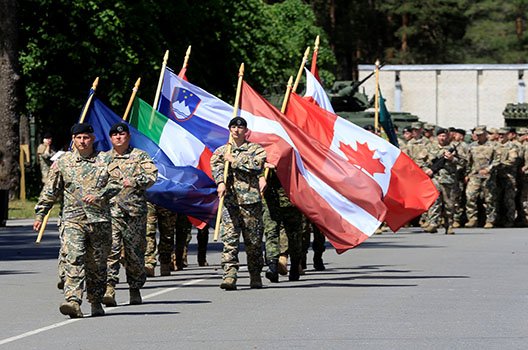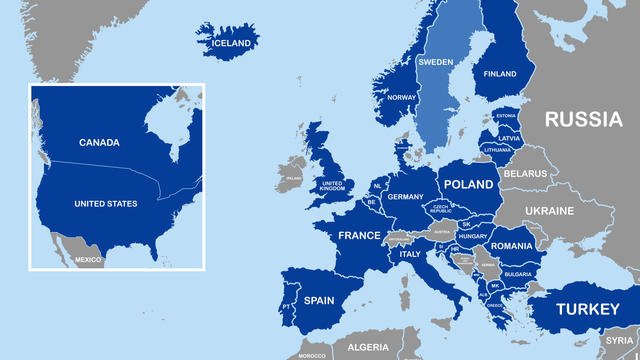The relationship between the United States and NATO (North Atlantic Treaty Organization) is a cornerstone of transatlantic security and has evolved significantly since NATO’s inception in 1949. This enduring alliance has faced numerous challenges and adaptations, reflecting changes in global geopolitics, security threats, and the evolving roles of both the US and NATO. In about 5000 words, I’ll provide an in-depth analysis of the historical context, the evolution of the relationship, key challenges, and prospects for the future.
I. Introduction to NATO
1.1 Origins and Purpose NATO was established in 1949 in the aftermath of World War II, primarily as a response to the perceived threat of Soviet expansionism in Europe. The founding members, including the United States, Canada, and several European nations, sought to create a collective defense mechanism to deter aggression and promote stability in the region. The core principle of NATO, enshrined in Article 5 of the NATO treaty, is that an attack against one member is considered an attack against all, obligating member states to come to each other’s defense.
1.2 NATO’s Expansion and Adaptation Over the decades, NATO has evolved from its original purpose of defending Western Europe against Soviet aggression to become a broader security alliance with global reach. The end of the Cold War brought about significant changes, including the reunification of Germany and the dissolution of the Warsaw Pact, NATO’s counterpart in Eastern Europe. NATO expanded its membership to include former Warsaw Pact countries and former Soviet republics, seeking to promote stability and democratic values in the region.

II. The Role of the United States in NATO
2.1 Leadership and Commitment As the principal architect of NATO and the world’s preeminent military power, the United States has played a central role in the alliance since its inception. The US has provided NATO leadership, military capabilities, and financial support, underscoring its commitment to European security. American military bases in Europe serve as vital hubs for NATO operations, and US forces regularly participate in joint exercises and missions alongside their NATO counterparts.
2.2 NATO as a Force Multiplier For the United States, NATO serves as a force multiplier, extending its influence and capabilities beyond its borders. By partnering with European allies, the US can project power more effectively, deter potential adversaries, and address common security challenges, ranging from terrorism to cyber threats. NATO’s integrated command structure and interoperable forces enable seamless coordination and cooperation among member states, enhancing collective defense and crisis response capabilities.
III. Key Challenges Facing US-NATO Relations
3.1 Burden-Sharing and Defense Spending One of the perennial challenges in US-NATO relations is the issue of burden-sharing, particularly regarding defense spending. The United States has long called on its European allies to increase their defense budgets and contribute more equitably to the common defense. While some NATO members have made progress in this regard, disparities persist, with the US accounting for a disproportionate share of NATO’s overall defense expenditure. This imbalance has fueled tensions within the alliance and raised questions about the sustainability of US commitments to NATO.
3.2 Strategic Divergence Another challenge facing US-NATO relations is strategic divergence, as evidenced by differences in threat perceptions, priorities, and foreign policy objectives among member states. The resurgence of great power competition, particularly with Russia and China, has prompted debates within NATO about the alliance’s strategic focus and posture. While the United States views Russia as the primary threat to European security, some European allies prioritize other concerns, such as terrorism, migration, and instability in the Middle East and North Africa. Bridging these strategic divergences and fostering greater unity of purpose within NATO remains a significant challenge.
3.3 Political Fractures and Alliances Recent years have seen growing political fractures within NATO, fueled by diverging domestic political dynamics, populist movements, and disagreements over issues such as trade, climate change, and multilateralism. The election of President Donald Trump in the United States, with his skepticism of traditional alliances and emphasis on “America First” policies, further strained US-NATO relations. While the Biden administration has signaled a renewed commitment to NATO and multilateralism, underlying tensions persist, and the alliance faces ongoing challenges in maintaining cohesion and solidarity.
IV. Prospects for the Future of US-NATO Relations

4.1 Strengthening Collective Defense Despite the challenges and uncertainties facing US-NATO relations, the alliance remains essential for transatlantic security and stability. Moving forward, efforts to strengthen collective defense capabilities, enhance military readiness, and modernize NATO’s deterrence posture will be critical. This includes investments in emerging technologies, cyber defense, and resilience against hybrid threats, as well as efforts to improve NATO’s ability to respond rapidly to crises along its periphery.
4.2 Promoting Burden-Sharing and Fairness Addressing the issue of burden-sharing will continue to be a priority for US-NATO relations. While progress has been made in recent years, NATO members must redouble their efforts to meet their defense spending commitments and invest in capabilities that enhance the alliance’s overall effectiveness. At the same time, the United States should recognize the value of burden-sharing in financial terms and political solidarity and shared responsibility for Euro-Atlantic security.
4.3 Adapting to Evolving Threats NATO must remain agile and adaptable in the face of evolving security threats, including conventional military challenges, terrorism, cyber-attacks, and disinformation campaigns. This requires ongoing investments in intelligence, surveillance, and reconnaissance capabilities, as well as efforts to bolster resilience and cooperation among member states. NATO’s partnerships with other regional organizations and non-member states will also be critical in addressing common security challenges and promoting stability in adjacent regions.
The relationship between the United States and NATO is fundamental to transatlantic security and stability. Despite enduring challenges and uncertainties, NATO remains a vital platform for collective defense, deterrence, and crisis management in an increasingly complex and unpredictable security environment. The United States and its NATO allies can strengthen the alliance and ensure its continued relevance in the 21st century by reaffirming their commitment to shared values, principles, and objectives.
